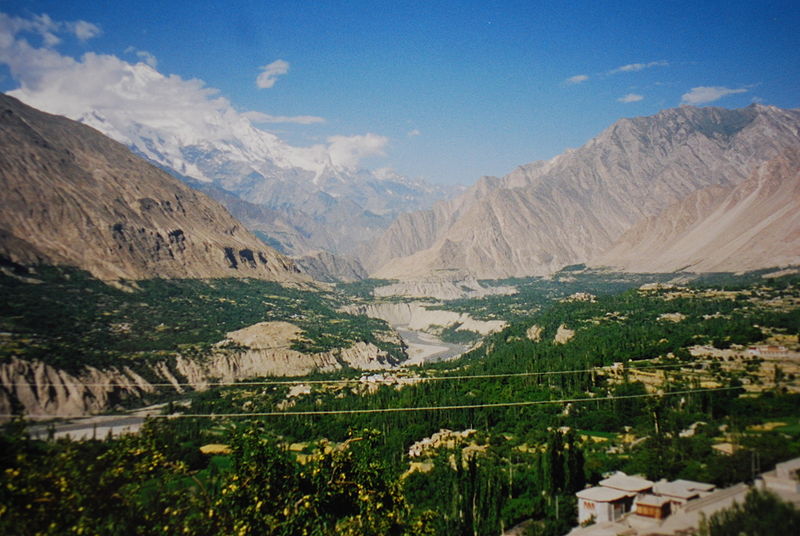Rakaposhi (RäkapoÅŸi) (Urdu: راکاپوشی), is a mountain in the Karakoram mountain range in Pakistan. It is situated in the Nagar Valley approximately 100 km north of the city of Gilgit in the Gilgit District of the Gilgitâ€"Baltistan province of Pakistan. Rakaposhi means "Snow Covered" in the local language. Rakaposhi is also known as Dumani ("Mother of Mist"). It is ranked 27th highest in the world and 12th highest in Pakistan, but it is more popular for its beauty than its rank might suggest. In a colloquial sense, i.e. measured from base to summit, Rakaposhi with its uninterrupted ~6000 m vertical rise, is the tallest mountain on Earth.
Rakaposhi was first climbed in 1958 by Mike Banks and Tom Patey, members of a British-Pakistani expedition, via the Southwest Spur/Ridge route. Both of them suffered minor frostbite during the ascent. Another climber slipped and fell on the descent and died during the night.
Park</span>

The people of Nagar have dedicated the Rakaposhi range mountain area as a community park. The Minister for Northern Areas inaugurated the park. The Rakaposhi mountain range is the home of endangered species such as Marco Polo sheep, Snow Leopard, brown bear, wolves and many other species.
Notable features

Rakaposhi is notable for its exceptional rise over local terrain. On the north, it rises 5,800 metres (19,029Â ft) in only an 11.5Â km (7.1Â mi) horizontal distance from the Hunza River. There are magnificent views of Rakaposhi from the Karakoram Highway on the route through Hunza. A tourist spot in the town of Ghulmat (located in the Nagar Valley) called "Zero Point of Rakaposhi" is the closest convenient view point of the mountain.
Time line

- 1892 Martin Conway explores the south side of Rakaposhi.
- 1938 M. Vyvyan and R. Campbell Secord make the first reconnaissance and climb a north-western forepeak (about 5,800m/19,000') via the northwest ridge.
- 1947 Secord returns with H. W. Tilman and two Swiss climbers, Hans Gyr and Robert Kappeler; they ascend via the Gunti glacier to 5,800m/19,000' on the south-west spur.
- 1954 Cambridge University team, led by Alfred Tissières, attempts the peak via the south-west spur but only reached 6,340m/20,800'. Also, an Austro-German expedition led by Mathias Rebitsch attempted the same route.
- 1956 A British-American expedition, led by Mike Banks, reaches 7,163m/23,500' on the Southwest Ridge, above the Gunti glacier.
- 1958 The first ascent, noted above.
- 1964 An Irish expedition attempts the long and difficult Northwest Ridge.
- 1971 Karl Herrligkofer leads an attempt on the elegant but difficult North Spur (or North Ridge).
- 1973 Herrligkofer returns to the North Spur but is again unsuccessful due to time and weather problems.
- 1979 A Polish-Pakistani expedition ascends the Northwest Ridge from the Biro Glacier.
- 1979 A Japanese expedition from Waseda University, led by Eiho Ohtani, succeeds in climbing the North Spur. Summit party: Ohtani and Matsushi Yamashita. This ascent was expedition-style, done over a period of six weeks, with 5000m of fixed rope.
- 1984 A Canadian team achieves a semi-alpine-style ascent of the North Spur, using much less fixed rope than the Japanese team had. Summit party: Barry Blanchard, David Cheesmond, Kevin Doyle.
- 1985-1987 Various unsuccessful attempts on the long East Ridge.
- 1986 A Dutch team climbs a variation of the Northwest Ridge route.
- 1995 An ascent via the Northwest Ridge.
- 1997 An ascent via the Southwest Spur/Ridge (possibly the original route).
- 2000 An attempt from the East side (Bagrot Glacier).
- 2003 A Mountaineering expedition team of Chiltan Adventures Association Balochistan led by Hayatullah Khan Durrani with coordination Malik Abdul Rahim Baabai & Noor Mohammad Khilji followed by Saad Tariq Saddiqi Manager of the team from Alpine Club of Pakistan (Islamabad) achieves ascent of the Southwest Spur/Ridge (first ascent route. expedition members Abdul Samad Khilji (Late)Mohammad Ali Khan Mandokhail (Late) Syed Taimoor Shah (Late) Nasibullah Khilji (Late) the others were stayed at 6000m,
Climbing routes
The routes with successful summits so far have been (see the timeline as well):
- Southwest Spur/Ridge (first ascent route). Long, but not exceedingly technical. Some tricky gendarmes (rock pinnacles). Has been repeated.
- Northwest Ridge. Long, and more technically difficult than the SW Spur/Ridge. Has been repeated.
- North Spur (a.k.a. North Ridge). Shorter than the above two routes, but much more technically difficult. Has been repeated, including a semi-alpine-style (capsule style) ascent.
Attempts have also been made from the east side (Bagrot Glacier), the East Ridge, and the North Face.
Gallery
See also
- List of mountains in Pakistan
- Northern Areas, Pakistan
- Highest Mountains of the World
- List of Ultras of the Western Himalayas
References
Sources
- Jill Neate, High Asia: An Illustrated History of the 7000 Metre Peaks, ISBN 0-89886-238-8.
- Andy Fanshawe and Stephen Venables, Himalaya Alpine-Style, Hodder and Stoughton, 1995 ISBN 0-89886-456-9.
- Himalayan Index
- DEM files for the Himalaya/Karakoram (Corrected versions of SRTM data)
External links
- Rakaposhi on Summitpost.org
- A list of mountains by local relief and steepness showing Rakaposhi as the world #3.
- Northern Pakistan - highly detailed place marks of towns, villages, peaks, glaciers, rivers and minor tributaries in Google Earth
- A Quick approach through lovely meadows leads to the base camp of RAKAPOSHI

Posting Komentar